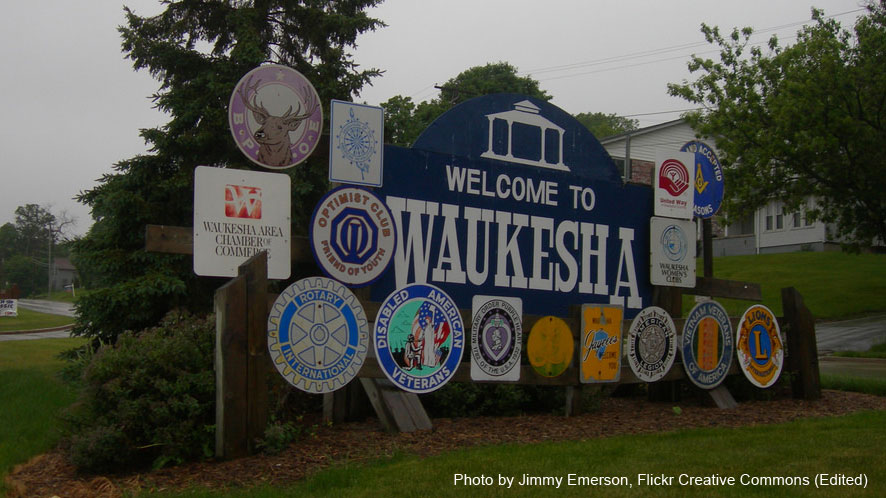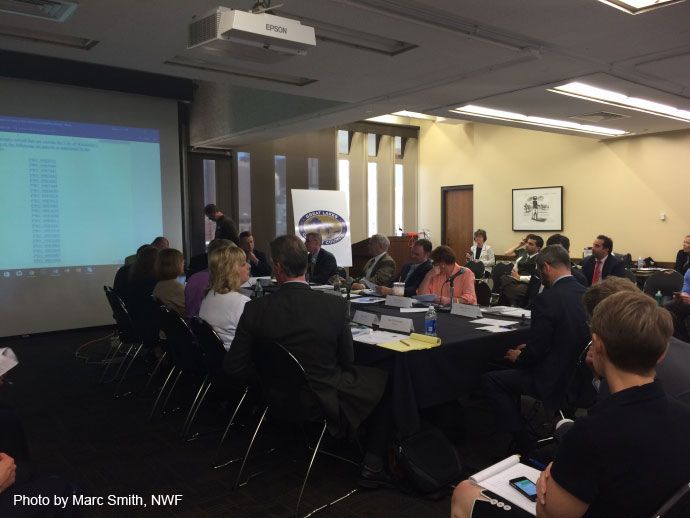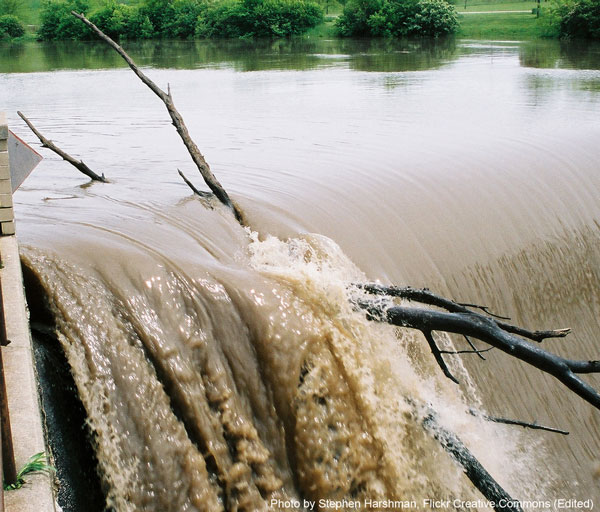In June, the Great Lakes-St. Lawrence River Basin Water Resources Council (or “Compact Council,” a panel representing the governors of each of the eight Great Lakes states, as well as two Canadian premiers who were unable to vote in the measure) voted unanimously to approve the City of Waukesha’s application to buy its drinking water from Lake Michigan. One “nay” vote would have killed the application. The historic decision marked the first time a US city outside of the Great Lakes Basin received such approval.

This vote was the culmination of a six-year application process by the City of Waukesha, which is facing radium contamination in its drinking water supply. Over the past six years, the city has needed to prove that there was no alternative to tapping into Lake Michigan, as stipulated by the 2008 Great Lakes Compact. Diversions are generally prohibited under the Compact, but there are some very limited exceptions. To fit within the exceptions, a community must be in a straddling county and meet, among other things, the following criteria (as taken from this piece by The Atlantic):
- Water returned to the basin must be equal in quality to the water taken out;
- Diverted water will be allowed only if there is no “reasonable” alternate water supply available;
- A comprehensive water-conservation program must be in place; and
- The diversion must not affect the “integrity of the Basin ecosystem.”
The city of Waukesha submitted its application to the Regional Body late last year. The Council met in April, May, and June to discuss the application. As a result of those meetings, the Council provided major revisions, which included important amendments from Minnesota and Michigan (see Marc Smith’s post below for more), before it approved the measure on June 21st.
Many environmental NGOs, scientists, policymakers, and other experts initially met Waukesha’s application as originally submitted with serious concern or outright opposition. But after the Compact Council added key conditions and amendments to the plan, several groups, including the National Wildlife Federation (NWF), agreed that Waukesha's diversion request as amended with conditions meets the Compact standards.
Others, for example the Sierra Club’s Wisconsin and Michigan Chapters, expressed disappointment in the approved plan. Such opponents believe that the approved application does not meet the conditions set by the Compact, specifically insisting that the Lake Michigan diversion is not the sole alternative to supply Waukesha with clean drinking water, and that the Wisconsin DNR and other member states of the Compact Council do not have the capacity to effectively monitor and enforce the diversion. They add that the diversion will do serious ecological harm to the Root River (the Compact dictates that water diverted must be returned; the water return system agreed upon will pump water back into the Root River on its way to Lake Michigan). They further add that many First Nations across the Great Lakes Basin oppose the plan, as do many of its mayors, many of whom have expressed feelings of having been unrepresented throughout the process.
So: Was the diversion “Waukesha's only option [to secure a] safe and sustainable source of water for its resident” as Mayor of Waukesha, Shawn Reilly, told reporters following the vote? Or was there a viable alternative as many groups insist? And is the diversion appropriate under the Compact, or does it set a bad precedent?
Our two authors (below) disagree. One, March Smith with the NWF, ensures us that the approved plan is sound and in accordance with the Compact. In contrast, Katharine Odell of the Sierra Club warns that the approval sets a dangerous precedent by failing to meet the conditions set by the Compact.
What are your thoughts? Share them on our Facebook page (look for the post announcing this blog piece) or on Twitter @WASAL.
—Meredith Keller, Wisconsin Academy of Sciences, Arts & Letters
Great Lakes Diversion Approved—Now We Bird Dog It
By Marc Smith
A version of this piece was originally posted here at Great Lakes Outdoors on June 22nd, 2016.

Yesterday [June 21st] in Chicago, the first Great Lakes diversion application under the Great Lakes Compact (Compact) was approved, with conditions. This is a sound decision.
Say what?
Didn’t almost everyone oppose this? Including National Wildlife Federation (NWF) and virtually every environmental and conservation group across the Great Lakes?
Yes, NWF opposed this diversion…as submitted. Check out our reason why we opposed this proposal as submitted here.
“As submitted” is an important nuance to highlight because, after it was submitted, the proposal was changed by the Great Lakes governors and Canadian premiers. These changes (or conditions added) brought the proposal closer in line with the Compact standards.
Others, including the Joyce Foundation, share this view. Take a look here.
Here is my take on this historic moment:
First, it’s important to remember that the Great Lakes Compact was developed to prohibit diversions of Great Lakes water and promote the wise use of our water resources inside the Basin. NWF and countless groups across the Basin helped negotiate and advocate for the adoption of this agreement. The Compact manages Great Lakes water in a protective, yet fair and sustainable way. Upon adoption in 2008, NWF and almost every conservation group in the Great Lakes Basin heralded this as a success.
While creating a ban on diversions, the Compact also allows very limited exceptions to this ban. These exceptions are limited and narrow for communities and counties that straddle the Great Lakes Basin. If a community meets this definition, then they can apply. Furthermore, a community must meet a set of criteria called the “exception standard” in order to be approved by all eight Great Lakes governors. The exception standard requires a community to: demonstrate a need for water, conduct a reasonable water supply alternative analysis, and return the water (less consumptive use), among other conditions.
Here is why I feel the Waukesha diversion approved with conditions is a sound decision for the Great Lakes.
First, the Great Lakes governors and Canadian premiers agreed with us that, as submitted, the Waukesha diversion application failed to meet the standards in the Compact. Because they agreed that it failed to meet the standards, they added conditions that narrowed it down and brought the proposal closer in line with the Compact standards.
Here are some of the important conditions included:
- Removed all towns and areas from the application that did not need water;
- Reduced the volume of water requested down from 16 mgd (million gallons per day) (this is the max capacity) to 8.2 mgd; and
- Strengthened the enforcement capability of any governor, or the Compact Council, to take actions necessary to compel compliance if Waukesha or the Wisconsin Department of Natural Resources (WDNR) fails to carry out the conditions placed on the proposal. This includes the ability of any governor to request an audit and inspection of how this diversion is being managed and enforced.
Moreover, Waukesha will return close to one hundred percent of the water diverted. This requirement was key if the diversion request was going to be approved.
It’s fair to say that the Great Lakes conservation community can take some credit; it was certainly instrumental in getting these conditions placed on the diversion. Up until the last moment, groups involved were trying to influence the final outcome. As a result—and I do not mean to beat my chest here—I certainly believe that the conservation community effectively drove the debate by raising the concerns with the proposal in a campaign blitz that ended up driving this process towards a better outcome. Let’s acknowledge that and feel good about our ability to influence and change the final outcome.
I feel the Great Lakes governors and premiers heard our and the public’s concerns and tried to address them. While all states and provinces contributed to the final outcome, I want to extend sincere appreciation to Michigan, Minnesota, New York and Ontario. Their thoughtful and serious review show that the Compact worked.
What precedent is being set here? Well, the way I see this is that this decision will set a very difficult path for the next diversion applicant.
Why? Consider that Waukesha spent close to $7 million alone in technical consulting fees. On top of that, they will spend approximately over $200 million to upgrade their infrastructure to accommodate the diversion. That’s right—$200 million. This will include wastewater treatment upgrades, water storage upgrades, infrastructure to hook up their supply, and infrastructure to return the treated wastewater back to the Great Lakes.
It should be noted that, given the process the Compact created, Waukesha had to go through the ringer of a difficult, years-long state review process, and a regional review process that created a sense of uncertainly as other governors and premiers changed this proposal, all leaving Waukesha to sit there and watch this unfold. Talk about a tense and stressful process! I believe this will create a barrier for any future community looking at a diversion. Who would want to go through this? Given this huge price tag, is it economically feasible to even begin to think about applying for a diversion? A community must have a very serious and desperate situation in order to choose to go through what Waukesha just went through. Alas, the Compact created this difficult path to get a diversion approved.
While not perfect, this approved diversion with conditions is a sound decision that upholds the Compact’s intent and spirit. Many groups and individuals may not be happy with this outcome, but the pragmatic side of me feels strong and confident that this decision will set a very difficult path for the next diversion applicant.
What now? Well, we need to review the public participation process for the next diversion application (let’s hope there isn’t one). Remember that this was the first application for a diversion under the Compact. The process wasn’t perfect and it was bumpy at times. Given this, there is agreement from some states and provinces that changes are in order to refine and improve this process in the future. We (at NWF) intend to work with the states and provinces to that end.
Lastly, questions remain over the ability of Waukesha and WDNR to manage and enforce these conditions. Given this, we will be watching. And we expect the governors to be watching. We are going to bird dog this thing and we reserve the right to take actions necessary to ensure that Waukesha and WDNR do what they are required to do.
Waukesha Diversion OK Puts Wisconsin’s Greatest Resource at Risk
By Katharine Odell
A version of this piece was originally posted here in the Capital Times on June 27th, 2016.

The Great Lakes are one of Wisconsin’s most important natural resources. The Great Lakes Compact, formalized in 2008, was created to make sure water stays in the Great Lakes to continue to provide substantial economic and recreational opportunities for our region for future generations.
As an avid canoeist and lover of all waters, I am anxious to see that this great natural resource be preserved. I am therefore concerned about the recent approval for Waukesha to divert Great Lakes water for its own municipal needs. I believe that this water diversion is both unnecessary and sets a bad precedent that other cities in any of the eight states bordering the lakes may decide to follow.
To meet the requirements of the Great Lakes Compact, a community must show there is no other feasible alternative to Great Lakes water to meet its needs. Waukesha has argued that because the aquifer from which it obtains its water contains radium, the city needs to access clean water from the Great Lakes.
The radium in the aquifer issue is real. In response to this concern, the Wisconsin Compact Implementation Coalition, a coalition of environmental groups in Wisconsin, conducted an independent analysis to evaluate Waukesha’s best water supply option (see Clean Wisconsin’s resulting alternative plan here). This research shows that Waukesha can sustainably meet its current and future water needs for its water service supply area by treating existing deep groundwater wells for radium and other contaminants. Indeed, other nearby communities, such as Brookfield and Pewaukee, which access the same aquifer, have successfully treated their municipal water for radium and other contaminants.
Because the City of Waukesha’s application failed to properly address the question of feasible alternative water sources as required by the Great Lakes Compact, it should have been denied. It was particularly disappointing that the Wisconsin Department of Natural Resources was a willing partner in putting forward a seriously flawed proposal.
It is notable that Waukesha Water Utility’s own estimates project a $334 million cost for its proposed Great Lakes diversion, which would increase residential utility bills from around $260 per year to almost $900 per year by 2024, and is significantly more expensive than the treatment option would cost. And now we hear that Waukesha is looking for federal dollars to help pay for this boondoggle. In addition, I am not impressed with the amount of money Waukesha has invested in the project. They have spent what amounts to three percent of the total cost of the project. This is, if anything, on the low side of what would be expected in the permits and approvals phase of a project of this size. Therefore, I do not think it will be a deterrent to others.
The Great Lakes Regional Body (GLRB), in assessing the Waukesha application, did make some improvements, such as restricting the service area and amount of water that can be diverted as well imposing as a monitoring provision. However, these modifications do not make up for the fact that the city never met the threshold question of proving that no other alternative exists.
In addition, the diversion will substantially affect the Root River for generations to come. Water diverted from the Great Lakes to Waukesha will be treated and returned to Lake Michigan via the Root River. Monitoring of the river, both for water quality and structural integrity, will be imperative. And the cost of that monitoring should be borne by Waukesha, not the citizens of Racine County.
The GLRB got the service area decision right, to their credit, but they missed the mark completely when they ignored the clear existence of a viable alternative, which should have resulted in denying the application. And they completely dismissed the 38,000 members of the public from around the entire Great Lakes Basin who took the time to comment in the public process this past winter—99 percent of whom opposed Waukesha’s receiving approval to use Great Lakes water. In addition, elected officials from around the region called for the application to be denied, including 11 of Michigan’s members of Congress, both Republicans and Democrats.
We can’t continue to treat our water resources recklessly or to ignore public sentiment. If we do, we will lose one of our most important resources for health, recreation and the economy.






